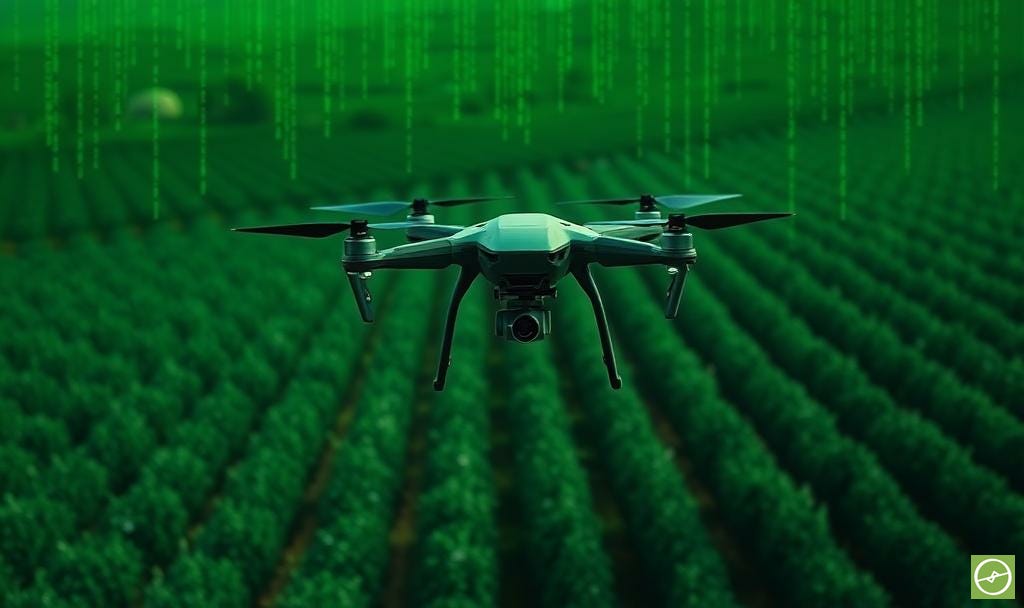See Stress Before It Strikes: How Multispectral Data Transforms Orchard Management
From NDVI to NDRE, drones are helping farmers catch problems earlier, fine-tune inputs, and build resilience.
Our eyes can only see a small slice of the electromagnetic spectrum. Red, green, blue. The rest is invisible. But not to multispectral sensors.
As with thermal datasets, these tools capture signals in near-infrared and red-edge light. Turning what’s hidden, into actionable data for the astute and discerning farmer.
At its core, multispectral imaging provides an extra layer of vision.
It reveals stress, nutrient imbalances, and disease pressures before they appear obvious to the naked eye.
For farmers, that means earlier interventions, better use of resources, and a stronger foundation for yield optimisation strategies and sustainability objectives.
NDVI: The broad health check
This is the multispectral index you have probably already heard of.
The Normalised Difference Vegetation Index (NDVI) compares near-infrared (strongly reflected by healthy leaves) with red light (absorbed by chlorophyll).
Healthy and vigorous plants score high, while stressed or bare areas score low.
NDVI has been around since the 1970s, when satellites first scanned the Earth for vegetation patterns. Today, drones bring NDVI down to tree-level, exposing canopy gaps, weak patches, and broad vigour differences. It works best in young orchards, vineyards, cover crops, or annuals where canopies are still open.
NDRE: The sharper stress detector
Now, the Normalised Difference Red Edge index (NDRE) takes things further.
By using the red-edge band (highly sensitive to chlorophyll content) it uncovers stress signals hidden in dense foliage, and is especially useful for mature canopies.
Nutrient shortages, irrigation imbalances, or disease prevalences, and any other limiting factors often show up here first.
If NDVI is the routine check-up, NDRE is the detailed medical scan.
It penetrates deeper into canopy layers, providing a clearer, earlier, holistic picture of plant stress. For established orchards and vineyards, this is the go-to index.
Timing is everything
Numbers only make sense when viewed in context.
A low NDRE during heavy flowering, for example, might reflect normal physiological stress rather than an actual problem.
That’s why timing drone surveys with your goals and crop phenology is essential:
Early season: NDVI highlights establishment, canopy growth, vegetative vigour, and survival rates in… new, young, replanted, or reworked orchards.
For established blocks NDVI will highlight plants that are usually too far gone, or on their way out.
Great for targeted removals and gap-filling initiatives - and useful for those upcoming nursery orders.
Mid-season: NDRE picks up subtle stress during peak growth. An absolute powerhouse of a metric for precision agricultural analysis and fine-timed action plans.
Used with metrics like thermal data, and digital elevation layers - this flight timing is one of the most utilised.
For best results, time for peak fruit/nut set, root flushes, or the start of oil-accumulation phases for relevant crop types like nuts and avocados.
Pre-harvest: both indices help to flag weak blocks and zones, guiding forecasting, and any pre-harvest interventions - depending on how much time you have before harvest.
Use start of fruit cell-enlargement / end of fruit cell-division stage, as a general guide if you want to survey early.
Conduct drone flights as close to picking as possible if you want to monitor peak stress levels and the trees that are really struggling to best optimise post-harvest nutrition to help negate “on season / off-season” yield fluctuations.
Post-harvest: track recovery after harvest, highlight stress carry-over into the next season, and guide nutrition strategies or replanting plans.
These drone scans are often utilised for setting up or fine-tuning Variable Rate Applications as part of orchard recovery (pre-dormancy for deciduous crops) and VRA planning for the season ahead.
PS: Repeated scans of any of the above (or a selection of the above in succession, conducted yearly) build a multi-seasonal story.
Instead of isolated snapshots, you get a living record of crop response over time. Your crop status vs interventions. Results vs historical performance. Data driven farming at its best.
NDVI vs NDRE:
Spoiler Alert: Use both.
NDVI is best for younger, smaller trees. Quick to interpret and excellent for spotting canopy presence and uniformity.
NDRE excels in mature blocks, catching problems NDVI may miss.
Together, they provide a complete picture. Overall vigour and hidden stress side by side. Best friends forever.
Beyond single metrics
Multispectral data becomes even more powerful when layered with:
Digital Elevation Models (drainage and slope insights)
Canopy metrics (growth and density trends)
Thermal imagery (transpiration and water stress)
Yield maps / AI Smart Sampling (linking stress to outcomes)
This integrated view shifts decisions from reactive to proactive; protecting yield, saving resources, and building resilience against volatility.
Multispectral imaging is not a silver bullet.
But it is a powerful looking glass.
One that helps us to move beyond guesswork and into a data-backed future.
Layered with other readily available metrics, it transforms how we see our orchards and how we respond to their needs.
The technology is here. The choice is whether we use it to sharpen our vision, optimise our yields, and secure the seasons to come.
The thinking starts here, but the real change starts when we take action.
Drone Data Metrics & Orchard Farming
Learn more about the core drone data metrics to utilise for enhancing agricultural efficiencies. Join for free and receive an email a day for a week, each lesson packed with info on drone-derived stats for Precision Agriculture.





